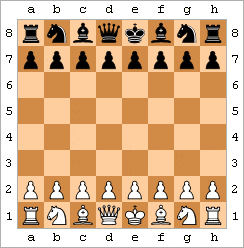
- Chess World Cup
- FIDE Grand Prix
- Olympiad
- World Championship
- List of strong tournaments
- List of world championships

- Checkmate patterns
- Chess openings
- Chess strategy
- Chess tactics
- Chess theory
- Endgames
- Pawn structure
- Problems/Compositions












|
 Animation demonstrating Fool's Mate
Animation demonstrating Fool's Mate |
||||||||||||||||||||||||||||||||||||||||||||
In chess, Fool's Mate, also known as the "Two-Move Checkmate", is the checkmate in the fewest possible number of moves from the start of the game. A prime example consists of the moves:
resulting in the position shown. (The pattern can have slight variations: White might play 1.f4 instead of 1.f3 or move the g-pawn first, and Black might play 1...e6 instead of 1...e5.)
Fool's Mate received its name because it can only occur if White plays extraordinarily weakly (i.e. foolishly). Even among rank beginners, the mate almost never occurs in practice.
Teed vs. Delmar, 1896| a | b | c | d | e | f | g | h | ||
| 8 |

                                |
8 | |||||||
| 7 | 7 | ||||||||
| 6 | 6 | ||||||||
| 5 | 5 | ||||||||
| 4 | 4 | ||||||||
| 3 | 3 | ||||||||
| 2 | 2 | ||||||||
| 1 | 1 | ||||||||
| a | b | c | d | e | f | g | h | ||
The same basic mating pattern can also occur later in the game. For instance, a well-known trap in the Dutch Defence occurred in the game Frank Melville Teed vs. Eugene Delmar, 1896:
A similar mate can occur in From's Gambit: 1. f4 e5 2. g3? exf4 3. gxf4?? Qh4#
More generally, the term Fool's Mate is applied to all similar mates early in the game. For example, in 1. e4 g5 2. d4 f6?? 3. Qh5#, the basic Fool's Mate pattern is the same: a player advances his f- and g-pawns, which permit the enemy queen to mate along the unblocked diagonal. One such Fool's Mate is widely reported to have occurred in a possibly apocryphal 1959 game between Masefield and Trinka which lasted just three moves: 1. e4 g5 2. Nc3 f5?? 3. Qh5#
Even more generally, the term Fool's Mate is used in chess variants to mean the shortest possible mate, especially those which bear a resemblance to the orthodox chess Fool's Mate. For example, Fool's Mate in the variant Progressive chess is: 1. e4 2. f6 g5?? 3. Qh5#
Greco vs. NN| a | b | c | d | e | f | g | h | ||
| 8 |

                           |
8 | |||||||
| 7 | 7 | ||||||||
| 6 | 6 | ||||||||
| 5 | 5 | ||||||||
| 4 | 4 | ||||||||
| 3 | 3 | ||||||||
| 2 | 2 | ||||||||
| 1 | 1 | ||||||||
| a | b | c | d | e | f | g | h | ||
A similar trap occurred in a game published by Gioachino Greco in 1625: